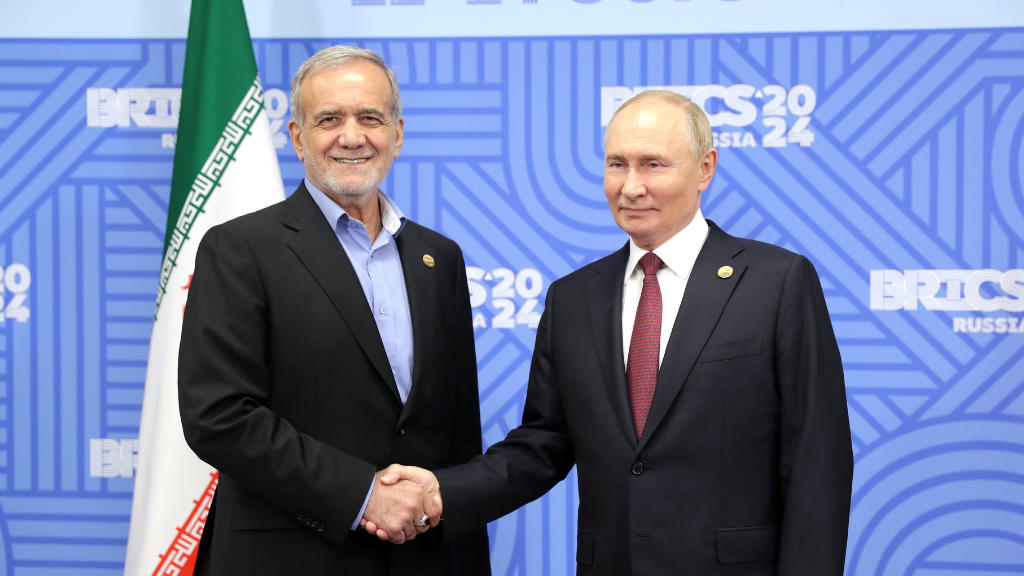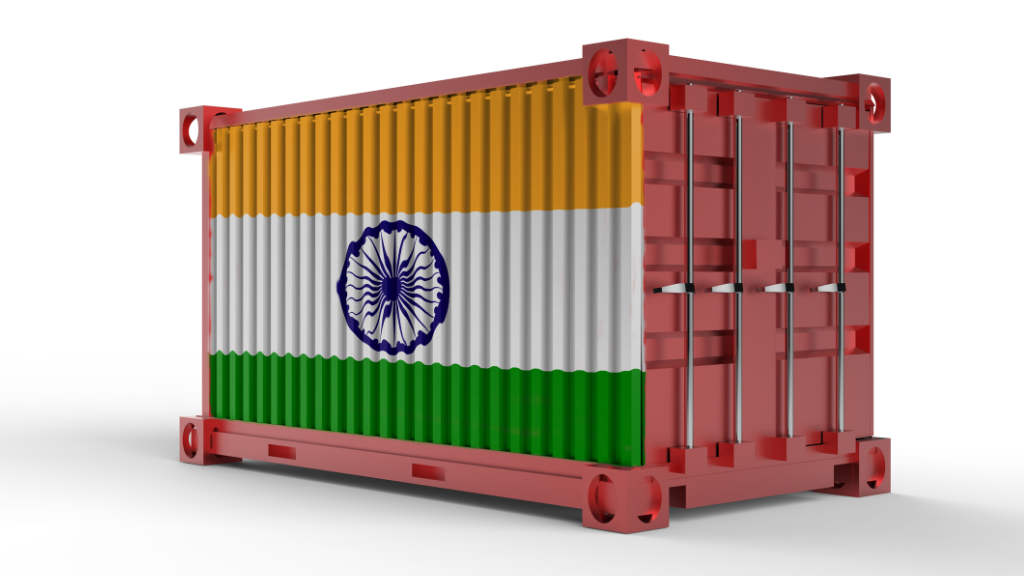Vladimir Putin has met with Masoud Pezeshkian, the President of Iran at the BRICS Summit in Kazan.
This is what they had to say:
Putin:
“This visit to Russia is your first as President of the Islamic Republic of Iran, and this has great symbolic importance. Iran has become a full participant of BRICS, and you know that we strongly supported your application. Earlier, we also vigorously promoted your accession to the Shanghai Cooperation Organisation. This has given us additional opportunities for cooperation in the international arena.
Recently, we had a very substantive and useful meeting in Ashgabat, where we reviewed the main aspects of bilateral cooperation and the most relevant regional issues. Most importantly, we reaffirmed our policy of mutually strengthening ties in every possible way. Our interaction is on the rise; it is genuinely friendly and constructive. Soon we will be able to consolidate the results achieved with a new major interstate agreement on comprehensive strategic partnership between Russia and Iran.
We are grateful to you for accepting the invitation to pay a separate visit to our country to sign this document and other important documents in a ceremonial atmosphere.
As I said in Ashgabat, one of our priorities is to consolidate the emerging positive trends in trade and economic cooperation. We expect this issue to be addressed by the intergovernmental commission, chaired by our Minister of Energy, Mr Tsivilev, and Iranian Minister of Petroleum Mohsen Paknejad.
Other priorities include the implementation of major joint initiatives such as the development of Iranian railway infrastructure as part of promoting a major project, the International North-South Transport Corridor project, as well as the construction of the second and third power units at the Bushehr NPP.
The Free Trade Agreement signed between Iran and the Eurasian Economic Union at the close of 2023 significantly contributes to the expansion of economic ties.
Cultural and humanitarian cooperation is likewise making good progress. Notably, an intergovernmental agreement concerning the establishment and operation of cultural centres came into effect in July of this year. Moreover, the visa-free regime for organised groups of tourists, operational since August of the previous year, is actively fostering an increase in mutual tourist exchange – a 52% growth was observed in 2023.
Today, we will continue our discussions on the most pressing international issues, including the dramatic developments in the Middle East, as well as the situations in Syria and the South Caucasus.
Generally speaking, I would like to emphasise that the approaches of Russia and Iran towards the global agenda are closely aligned or fully coincide. We are united by a shared aspiration to establish a just multipolar world order, to uphold international norms, and to maintain the pivotal role of the United Nations.
I would also like to take this opportunity to extend my greetings and best wishes to the Supreme Leader of Iran, Ayatollah Seyyed Ali Khamenei. We hold in high regard his attentive and constructive approach to the development of Russian-Iranian relations.”
“I express my gratitude for your invitation to visit Kazan. I am very pleased to have this opportunity to meet with you.
As you mentioned, we had a very productive meeting in Ashgabat, during which certain agreements were reached. I have assumed personal oversight of the implementation of these agreements and have just spoken with my colleagues and ministers to finalise at this meeting matters left by the previous Government of Iran. If necessary, I will personally attend to this matter once again to ensure that all agreements and documents are signed at the earliest possible opportunity.
Our relations are of a strategic nature – it is in the interests of our nations to advance together. Our esteemed neighbour, Russia, is a great country.
We must continue our constructive collaboration within the BRICS framework. With your support, we have a Free Trade Agreement with the EAEU, and have joined the SCO, and BRICS, for which we are sincerely grateful. We will undoubtedly and actively continue along this path.
I believe that today’s discussions are also aimed at comprehensive cooperation with BRICS countries.
I am confident that we will be able to neutralise all the sanctions the United States has imposed on us, on you and us, and we shall be able to straighten out all the processes they are attempting to disrupt.
Our relations across various spheres – economic, political, and cultural – are developing exceedingly well. I am certain that we will soon be able to sign the treaty. At the earliest opportunity, we shall finalise this issue; we shall agree on this matter. I believe that the date for the signing of this treaty will soon be determined.”
Analysis & Implications
Pezeshkian actually met with Putin only a few days ago, holding discussions in Moscow that we highlighted here. That contains details of bilateral trade and statistics.
Like Russia, Iran has been heavily sanctioned by the United States and European Union, mainly due to developing Nuclear Power Plants (NPP) to drive its economy. Israel objects saying that the true objective is to develop nuclear weapons and to attack it. The stand off does have regional implications – it means that without NPP, Iran cannot export electricity much needed in neighbouring Pakistan – whose Baluchistan Province is amongst its poorest and as a result, prone to civil unrest and terrorism. Sanctions have also significantly hindered the Iranian economy, which given its relatively educated population of 92 million and significant oil and gas reserves (the world’s second largest gas reserves, and third largest oil reserves) ought to be a wealthy country. Instead, its GDP is just US$382 billion.
The only way out of this predicament for Iran is both patience and allegiance to groups such as BRICS. Pezeshkian would have been keen to discuss trade with other BRICS members – and Iran already has close relations with China, its main client.
Of significance however in this meeting were the references to the ‘Russia-Iran Comprehensive Strategic Partnership’, a long-discussed document that would secure mutual trade and investment between the two countries for 20 years. In a nutshell, this agreement cements long term relations in military support, trade and agriculture.
The anticipated agreement would usher in a new chapter in Russia-Iran relations, deepening their strategic and economic ties at a critical moment when both nations face increasing isolation from the West. This partnership underscores a shared commitment to countering Western influence, and the sweeping sanctions that have followed. Since 2022, there has been a notable increase in Russian-Iranian cultural, educational, and economic exchanges, largely in response to the unprecedented global isolation imposed on both nations.
The two countries are key allies in bypassing Western sanctions. In 2023, Russia became the largest foreign investor in Iran, accounting for roughly two-thirds of its total FDI. Joint projects have been developed in the oil and gas sector, as well as in energy and logistics; Russia supplies Iran with grain and oilseed, lumber, inorganic chemicals, machine-building equipment, paper and cardboard, and measuring instruments. In turn, Iran has exported vegetables and fruits, nuts, dairy products, plastics, ferrous metal products, building metals, and plumbing products to Russia. New collaborations have also begun to crop up. On June 26, 2024, Gazprom and the National Iranian Gas Company signed a strategic memorandum on the prospects for a Russian natural gas pipeline to Iran.
Russia has also worked with Iran to develop alternative financial systems and circumvent the use of the U.S. dollar in their transactions. In the first quarter of 2024, a currency agreement was signed between Iran and Russia, allowing the two to trade in both Rubles and Rials. Sberbank and Bank Melli, the largest banks in Russia and Iran, each agreed to open credit lines for 6.5 billion rubles, and a pilot project in accepting payment by cards using the Russian ‘Mir’ system has also been launched in Iran. Moreover, Hossein Eivazloo, Deputy Director of Foreign Investment at the Iranian Development Fund, revealed plans for Iranian and Russian national wealth funds to build joint investment committees. Various projects will be realized in oil, gas, petrochemicals, high-tech, and pharmaceuticals.
The two states have also worked together to develop their military and defense strategies and capabilities, despite the wide range of sanctions levied against them. Iran has supplied Russia with thousands of Shahed drones, Iranian military officials have trained Russian soldiers on the use of the drones, and the two countries are working together to construct a drone factory in Russia. In January, Iran also confirmed an order for the purchase of Russian Su-35 fighters, as well as other military equipment, including helicopters and missiles. In November 2023, Iranian deputy Defense Minister Seyyed Mehdi Farhi said that a deal had been struck on the purchase of Russian MI-28 attack helicopters, SU-35 fighters, and Yak-130 combat training aircraft. Deliveries have already begun.
Putin has already ordered that the agreement be signed off by the Russian government. At present though, Pezeshkian is still relatively new in his position, while Iran is in an extremely delicate position as concerns Israel and does not want to be part of an ever-widening circle of regional violence. Signing off the Russian Strategic Partnership Agreement at this moment in time could be highly provocative. The signs point to Tehran wanting to see an Israeli de-escalation prior to signing an agreement with Russia – meaning Putin’s agreement may have to wait a little longer.
That said, when it does occur – it will further boost Russia-Iranian trade ties, and provide additional regional security – a development that could be behind Saudi Arabia’s no-show at this BRICS summit.
In addition to this, Putin also made reference to the International North-South Transportation Corridor (INSTC) which bisects Iran and is set to become a vital trade route for Russia, as it links directly to Central and South Asia (overland transit is already being carried out between Pakistan and Russia) as well as south to the Middle East, East Africa and South Asian regions. India has been a major investor in Iran’s Gulf coast ports, but Iran itself has sometimes not planned for the infrastructure developments especially well, and this has led to bottlenecks, delays and costs – Russia has had to step in financially to complete the vital Rasht-Astara railway. Putin will be keen to develop a good working relationship with Pezeshkian, and will appreciate that Iran is also in an extremely complicated position. But at the end of the day, Putin will want results, and will expect Iran – and Pezeshkian – to deliver.
Further Reading





